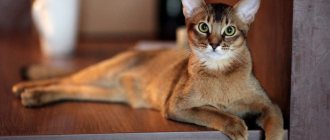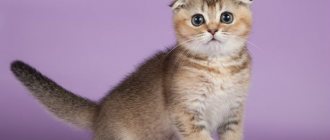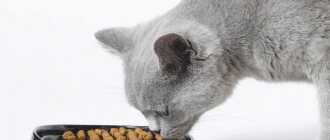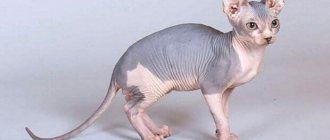In this publication we will look at what and how much to feed a Scottish kitten, and what food is suitable for Scottish kittens. Moreover, contrary to the opinion that if you have a Scottish Fold cat (Scottish Fold or Highland Fold), you need to feed it differently than a straight-eared cat (Scottish Straight and Highland Straight) so that its ears do not stand up, in fact In fact, the same diet is suitable for both varieties of the Scottish breed. Scottish Fold and Straight-eared kittens are at a developmental stage, so the question of what to feed is very important.
Article continues after advertisement
Scottish Shorthair cat - features of the breed
Before getting an animal, especially a blue-blooded cat, you should know all the characteristics of the breed. It just so happens that when choosing a pet, potential owners pay attention only to the positive aspects of the breed, without taking into account the nuances of care and possible problems.
The Scottish cat is a very common breed. Unfortunately, the more popular the breed, the more amateur breeders sell kittens with poor genetics. Such kittens are sold cheaper than their counterparts with documents. In addition, many potential owners choose pets solely based on appearance, for example, the shape of the ears or color.
The Scottish cat breed is divided into two large groups:
- Shorthair – stay and fold variety.
- Longhair (Highland) - stay and fold variety. Note that, by and large, Highlands are a completely different breed that has common roots with Scottish Shorthair cats.
Scottish cats are sociable, independent, clean and attractive. Cats with good heredity rarely develop health problems.
Amateur-bred animals often suffer from food allergies, skin problems, diseases of the musculoskeletal system and the cardiovascular system. Naturally, among shorthaired Scots, Fold kittens are more popular.
Important! Do not confuse Scottish and British cats. The British are only straight-eared with a gray (blue) color.
Scottish Fold kittens - features
Scottish fold kittens (folds), in theory, differ from their straight-eared counterparts only in the shape of their ears. In practice, everything is much sadder. Fold kittens are in high demand, so unscrupulous sellers use various tricks to increase their income. In the best case, kittens' ears are glued or pressed to the head with tight bandages. The ear cartilage does not form correctly and the kitten is called a fold. In this case, nothing threatens the animal’s health, except that there is a risk of developing chronic otitis media.
In the worst case, unscrupulous breeders breed two fold-eared parents. Kittens from such mating are disabled from birth. It is only a matter of time before animals develop malformations of the musculoskeletal system.
Some kittens from these litters are born with deformed hind legs and are unable to walk. In others, the deformities may appear later, leading to chronic pain or paralysis of the hind limbs. Unfortunately, if a kitten is born from a fold + fold mating, no amount of care or even the highest quality nutrition will change the situation.
Scottish straight kittens
Scottish straight-eared kittens (straights) do not have the vicious gene for lop ears, so nothing threatens the health of their musculoskeletal system. The breeder will warn you about the risk of allergies (if you buy a kitten from a reputable seller), and the babies will be examined for other ailments before sale.
Important! All British and Scottish cats are prone to heart failure and do not tolerate anesthesia well.
General feeding rules
Typically, kittens are purchased at the age of 3-4 months, when their body is able to do without mother’s milk and is partially accustomed to new “adult” food. To correctly create a menu and feed your baby, you need to take into account a number of factors:
- The baby's stomach is very small, and activity is increased, so feeding should be frequent and portions small. For example, at the age of 3 months, a kitten is fed 5-6 times a day, and an older 4-month-old baby needs to be fed 4 times a day;
- a pet that does not have enough food will develop poorly, lag behind its peers, and often get sick;
- overfeeding is also dangerous. Unspent calories will definitely lead to obesity and disease;
- new products are introduced gradually, starting with small portions. Feeding with different foods must be alternated, that is, meat for breakfast, fish for lunch, cottage cheese for dinner. This is how the stomach learns new tastes and gradually gets used to them;
- You can’t pour the entire daily portion into your baby’s plate. His stomach is not yet able to control itself, which is dangerous due to overeating;
- food should not be too hot or cold. The kitten may get burned or have a cold in its throat. It is advisable to slightly warm foods before feeding.
What to feed a Scots kitten - choosing the type of diet
Considering the tendency to food allergies, you need to carefully choose what to feed your Scots kitten.
You need to choose from three options:
- Natural feeding.
- Industrial feeding.
- Mixed feeding.
Each feeding option has advantages and disadvantages for both pet and owner.
Natural diet
A natural diet for a Scots kitten includes:
- Feeding raw and cooked foods in pure and mixed form.
- Feeding exclusively raw foods is a raw food diet.
- Feeding with homemade semi-finished products.
Benefits of a natural diet:
- Food is better digested.
- You can control the freshness and quality of the products.
- You can adjust the diet according to your pet's needs.
Flaws:
- The risk of food allergies to “store-bought” products.
- Food for your pet needs to be prepared regularly, separately.
You can start feeding a Scottish kitten with natural products from the age of one month. Until approximately 7–8 months of age, the kitten can be given all foods (except prohibited ones) that attract its attention. By the age of one year, the pet will have formed its own taste preferences.
Ready-made feed
Ready-made feeds are divided into types:
- Dry – granules.
- Semi-moist - pieces with gravy or jelly.
- Wet - pate or paste.
- Treats.
The better the food, the more expensive it is. Based on quality, finished feed is divided into classes:
- Economy
- Premium
- Super premium.
- Holistic.
Note! Some food manufacturers produce highly specialized lines for British and Scottish cats.
A healthy kitten can be given daily shorthair cat food on a regular basis. If there are any inclinations or health problems, food is selected from a narrow range:
- Supportive.
- Preventive.
- Medicinal.
- For exhausted kittens and adult animals.
Advantages of ready-made feed:
- Saving the owner's time.
- High-quality feed contains all the necessary vitamins and taurine.
- High-quality feed is balanced.
- It's easy to calculate the daily requirement.
- They are stored for a long time.
Flaws:
- You cannot be sure of the quality of the food; even the best and most expensive products are often counterfeited.
- Ready-made food of good quality will cost more than a natural diet.
- If a kitten develops an allergy, it is almost impossible to “calculate” the allergen.
A kitten can be fed pates from the age of one month. Semi-moist food is introduced into the diet at 2–3 months. Dry food is possible after a complete change of teeth.
Mixed diet
A mixed diet involves feeding natural and mixed foods at the same time. Since a mixed diet is a direct path to dysbiosis, it is strictly not recommended for feeding a Scots kitten.
Important! A kitten will not be able to digest food of different textures (even eaten at different times) until 4-5 months of age.
Types of food
There are several options for feeding cats:
- natural, when the pet is offered a choice of meat, fish, minced animals;
- feeding with industrial feeds. These can be dry treats or jelly-like canned foods;
- mixed option, but it is not recommended to literally mix dry food and natural products. For breakfast there can be canned food, and for dinner a full-fledged minced chicken cutlet.
Veterinarians do not recommend using a mixed version, citing the fact that in this case it is difficult to avoid an overdose of vitamin supplements. An imbalance of vitamins and minerals in the body causes disturbances in the functioning of the body. Also, with mixed feeding, animals often experience digestive disorders and constipation, which can lead to diseases of the gastrointestinal tract.
The choice of food depends on the owner’s employment, their financial capabilities, and the pet’s taste preferences. It should be remembered that the diet should be varied, but at the same time balanced. Obesity is dangerous to the health of any cat. Problems with excess weight arise if the owners do not control the calorie content of their dishes and indulge their constantly meowing pet.
It is best to feed animals according to a schedule and a pre-compiled menu. Neutered cats are usually found with the problem of excess body weight, so special attention is paid to their diet.
Many pet owners argue about the correct choice of food. Some insist on a natural diet, others say that industrial feed is much healthier and tastier. It is difficult to prove anyone is right in this situation. Feeding natural foods is problematic for many. This requires frequent trips to the market or store. Meat and fish must be fresh.
In addition, fresh meat and fish delicacies may contain worm larvae, which can lead to the development of helminthiasis. To avoid infection, you will need to boil or bake a dish for cats, because fried food is harmful not only to the human body, but also to the cat’s stomach.
Ready-made food does not take much time to feed. It is enough to pour a certain portion to clearly know that your pet will not go hungry until the evening.
Sample menu by age
A sample menu by age will help you assess your ability to care for your future pet. The recommendations below are not clear instructions; always rely on the rate of development, growth and weight gain of your pet.
Important! To adequately assess the diet, weigh the kitten regularly. Sudden changes in weight will tell you how and when to adjust the menu.
Menu for a kitten up to a month
Up to a month, kittens feed only on mother's milk. If the baby is orphaned, he needs to be artificially fed.
Artificial feeding of a newborn kitten
Usually babies up to 1-3 months are fed by a mother cat. There are situations when the offspring is left without a mother, and a person takes on the role of nurse. This is a very important mission, which sometimes seems impossible. Nothing is impossible, the main thing is desire and skill. The best option is to ask your friends if they have a nursing cat. Usually the mother does not refuse to feed her foundlings.
If this option is not available, start feeding from a pipette. Before feeding, babies are weighed, this allows you to determine the required amount of food. A 100-gram baby will need 30 ml of formula or milk, which is how kittens are fed during the first week after birth.
Starting from the second week, the nutritional intake is increased. For every 100 g of baby's weight, at least 38 g of liquid food is needed. In the third week, at least 48 g is already required. Starting from the next month, the norm increases to 53 g.
During the first month, the baby should receive food multiple times (up to 10 times a day). For feeding, warm milk or cream is used, which is poured into the baby’s mouth using a pipette or syringe without a needle. This must be done carefully so that the kitten does not choke.
Cow's milk is slightly different in composition from cat's milk. For example, there is less water in cat milk (70%) than in cow milk (88%), and the fat content is higher - 11% and 3.25%, respectively. But the most important difference is the amount of lactose. There is almost 2 times more of it in cow milk (5.2%) than in cat milk (3%).
The pet store sells a special formula for newborn kittens, which is similar in composition to a cat's mother's milk and is more suitable for feeding babies than cow's milk.
Vitamins and supplements in the diet of a Scots kitten
If you decide to feed your pet natural products, you need to add vitamins and supplements to his diet. Natural vitamin supplements for Scots kitten:
- Meat and bone meal.
- Fish, chicken, beef liver.
- Greens, vegetables, fruits.
- Sunflower oil, olive oil.
- Brewer's yeast.
Unlike dogs, cats need taurine. Without this amino acid, a kitten can become disabled and even die.
When feeding natural food, sources of taurine should be included in the diet:
- Turkey.
- Rabbit.
- Chicken heart, liver.
- Beef heart.
- Pork, ham, trimmed of fat, after deep freezing.
- Pork liver, heat-treated.
- Ocean fish, shellfish.
- Raw red fish.
- Homemade live yogurt.
- Whole milk.
Pharmaceutical products can be used as additional sources of nutrients:
- Fish fat.
- Feed tricalcium phosphate.
- Omega-3, Omega-6.
- B vitamins.
Note! Manufacturers of feed and veterinary drugs produce special, complex, vitamin preparations in the form of powders, tablets and crackers.
Advantages of ready-made feeds
Why are more and more owners of kittens switching to ready-made food? Perhaps the secret is that everyone wants to have a kitten, but there is simply no one to care for and feed it. Constantly being busy at work means that owners have no time to boil meat, fish, or grind food to remove bones.
Ready-made food has many advantages. Premium mixtures are designed for feeding cats, taking into account their age, body type, belonging to a specific breed, and are even available for neutered and lactating pets.
Popular foods that are suitable for Scottish babies:
- Wahre Liebe "Junge", produced in Germany. The food contains colostrum, so the product is well absorbed and can be used for feeding from the earliest months. In addition, the food contains chicken and turkey meat, as well as rice, egg and beet pieces. The manufacturer assures that the food can be used to prevent urolithiasis.
- Fans of the fish menu will appreciate Hill's Science Plan Kitten Tuna - dry food, made in the USA. It contains: floured tuna meat, chicken, animal fat, flaxseed, corn, beets, fish oil, Omega-3 and Omega-6 acids. Kittens really like the food. Long-term use helps strengthen the immune system.
- Canadian manufacturers offer high protein dry food 1st Choice Kitten. It contains, in addition to chicken and herring meat, rice, barley, oatmeal, egg powder, tomato and beets. The food is hypoallergenic, therefore suitable for pets suffering from food allergies.
- Another dry food from French manufacturers is Royal Canin British Shorthair Kitten, containing dried poultry meat, extract from cartilage and crustacean shells, fish oil, corn, and chopped beets. According to the annotation, the food is a preventative against joint pathologies.
- For lovers of wet food, the French offer Royal Canin Kitten Instinctive. In addition to meat and meat products, it contains cereals, yeast and milk.
- The manufacturer Purina Pro offers Plan Dental Plus food for small kittens. The unique composition allows you to maintain your pet’s oral cavity in excellent condition. The food prevents the formation of dental plaque.
- Hills high carbohydrate food is designed for active kittens. It contains calcium and magnesium, which the baby needs for full development. The food is not suitable for overweight kittens.
The calorie content and consumption rate must be indicated on food packages, so you must follow the manufacturer’s recommendations. The average norm for a Scottish kitten is 200 kcal.
Ready-made food is divided into the following types:
- dry;
- wet;
- semi-moist.
When choosing dry food, you need to remember about constant access to a drinking bowl, otherwise the cat will have problems with bowel movements.
Dry and wet formulations from the same manufacturer are allowed to be used for mixed feeding. At the same time, they are not combined into one feeding, but distributed alternately:
- one feeding – dry portion;
- second feeding - wet canned food.
Dry food must be stored properly. Before purchasing a package of food, you should pay attention to the following points:
- expiration date and storage conditions;
- manufacturer's brand and type of food (it is best to choose a premium and holistic line);
- the age of the pet indicated on the packaging and actual age;
- special additives. The food may contain increased amounts of certain microelements and vitamins. Feeds are not only balanced, but also medicinal. Not all kittens need special food, so you should pay close attention to the instructions on the food.
Prohibited Products
It is important to exclude prohibited foods from your Scots kitten’s diet:
- Bones, pure fat, skin, especially poultry.
- Palm oil.
- Grapes, raisins.
- Juicy and sweet fruits.
- Soy.
- Mushrooms.
- Corn and semolina.
- Raw freshwater fish.
- Dry, salted fish.
- Products containing sugar or sugar substitutes.
- Products containing xylitol (chewing gum, some sweets).
- Products containing flour or yeast.
- Products containing caffeine, cocoa, any stimulants (sweets, tea, coffee, chocolate)
- Products containing marinades, salt, spices.
- Smoked products, including sausages, balyk, fish.
- Expired products.
- Leftovers from the table.
Controversial foods in the diet are:
- Fresh pork is a source of helminths and false rabies.
- Raw ocean fish are a source of helminths.
- Whole milk – risk of individual intolerance.
- Chicken eggs are an allergen.
- Factory-bred chicken – risk of allergies and individual intolerances.
- •Raw and boiled chicken liver in large quantities.
- Cereals.
Controversial products can be given to a kitten if an allergic or other acute reaction does not occur after taking them.
Feeding frequency
The number of feedings depends on the age of the kitten. The approximate diet and number of feedings per day are presented in the table (on a mobile device you can scroll the table horizontally with your finger):
| Pet's age, months. | Number of feedings | Example of products and dishes used |
| 1 | 6-8 | Warm milk semolina porridge, baby formula, a small amount of boiled chicken yolk. |
| 2 | 5-6 | Low-fat cottage cheese, milk, semolina porridge, a small portion of boiled and chopped meat (10-15g). |
| 3 | 4-5 | Boiled minced meat, cottage cheese, kefir, chopped vegetables, baked or boiled fish, porridge. |
| 4-6 | 3-4 | Fermented milk products, meat, minced meat, cartilage, fish, fresh and boiled vegetables. |
| over 6 | 3-2 | All permitted products. |
Vaccination, vaccinations
The first vaccination for a Scottish Fold kitten must be done at the age of 3.5 months. The animal must first be treated for worms and fleas.
It is also very important that the kitten is completely healthy before vaccination.
The vaccine is given twice, with a three-week break, and then repeated every year. Adult cats also receive an annual rabies vaccination. Kittens are also recommended to be vaccinated against ringworm; it is given at the age of 3 months to six months. All vaccination notes must be included in the animal’s veterinary passport. This is necessary so that there are no problems when leaving your region.
How to care
Any owner of a straight-eared Scottish cat should not forget that they need not only food and care for good immunity, but also affection with tenderness. In this regard, it is so important to purchase such a baby only if you can give him a lot of attention every day.
However, taking care of these cats is not at all difficult, nor does it require spending a lot of time and money.
Initially, you should figure out what kind of food Scottish Straight babies need, since food largely determines the pet’s immunity and life expectancy. When caring for a kitten, you should follow the main points listed below and strive to maintain the temperature in the house at 19-23°C. Watch how to care for a kitten.
Scottish Straight cats are very clean dogs, so the owner can only brush them a couple of times a week and sometimes wash them. This breed has a short coat, but it is necessary to take care of it. It is good for the baby to get used to the process of combing at a very young age; it is more difficult to accustom an adult.
You should know that high-quality fur care can only be achieved with the use of special shampoos and at least a couple of combs.
Caring for an old pet
The aging body of a Scottish cat is more susceptible to various diseases than young individuals. During this period of time, arthritis may develop, the pet’s behavior may change, and problems with the functioning of the stomach and intestines may arise.
To avoid problems, you should select food that is appropriate for the age of your pet. Conduct a preventive examination of the cat with a veterinarian and monitor the health and emotional state of the Scottish cat.
After a walk, the cat is checked for ticks and fleas. Often the Scots do not walk outside, they stay in the apartment, but if the pet is taken outside the house, a subsequent examination is necessary.











